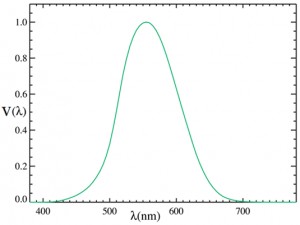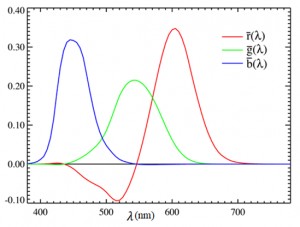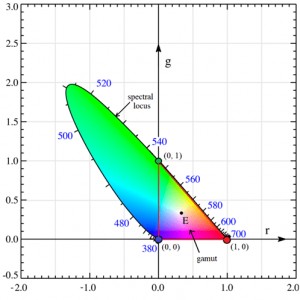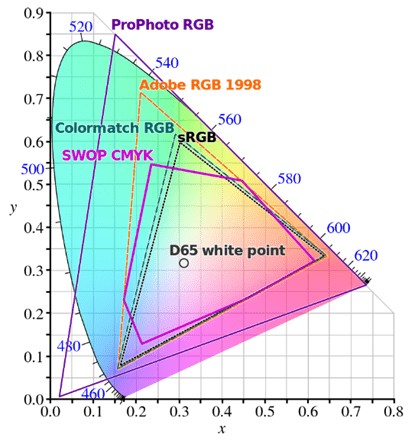CIE colorimetry, a pivotal field in color science, provides a standardized method for objectively measuring and specifying color. This comprehensive guide, brought to you by CONDUCT.EDU.VN, will demystify the principles of CIE colorimetry, exploring its applications in various industries, and highlighting its significance in ensuring color consistency. Dive in to learn about color measurement and color standards.
1. Understanding the Fundamentals of Colorimetry
Colorimetry is the science and technology used to quantitatively measure and describe color. It moves beyond subjective human perception, using numerical values to represent colors in an objective and reproducible manner [1]. This is crucial in fields where color accuracy and consistency are paramount.
1.1. Human Color Perception: The Foundation
Our ability to perceive color stems from specialized cells in the retina:
- Cone Cells: These are responsible for daylight vision and color perception. Humans possess three types of cone cells, each sensitive to different wavelengths of light: short (S, blue), medium (M, green), and long (L, red). This trichromatic nature of human vision forms the basis for many colorimetric systems [2, 3].
- Rod Cells: Primarily responsible for night vision, rods are highly sensitive to light but do not contribute to color perception.
1.2. Metamerism: When Colors Appear the Same
Metamerism describes the phenomenon where two different spectral distributions of light appear to be the same color to the human eye under specific viewing conditions. This happens because the two different light sources stimulate the cone cells in our eyes in the same way. Colorimetry aims to address this by providing a standardized way to define color that is independent of specific viewing conditions [4].
1.3 Colorimetry in Practice: Standardized Color Definitions
Colorimetry’s core purpose is to establish an objective, unambiguous method for defining color. This ensures that colors can be accurately communicated, reproduced, and measured across different devices, materials, and industries, mitigating the effects of metamerism and subjective perception.
2. The CIE 1931 Color Space: A Historical Milestone
The CIE (Commission Internationale de l’Éclairage), or International Commission on Illumination, introduced the CIE 1931 color space as a foundational standard in colorimetry. This color space was a landmark achievement, providing a standardized way to represent colors based on human vision.
2.1. The Luminous Efficiency Function: V(λ)
Before the CIE 1931 color space, the CIE published the luminous efficiency function, V(λ), in 1924. This function describes the average human eye’s sensitivity to different wavelengths of light under daylight conditions. It indicates that our eyes perceive different wavelengths with varying brightness, even if they have the same radiance [4].
2.2. RGB Color Matching Functions
The CIE 1931 color space was developed based on the work of William David Wright and John Guild. Their experiments involved having observers match a monochromatic reference light by mixing three primary lights: blue (435.8 nm), green (546.1 nm), and red (700 nm). The results were the 1931 RGB color matching functions, which quantify the amounts of each primary light needed to match a given color [4].
2.3. Addressing Negative Values in Color Matching
A peculiar aspect of the RGB color matching functions is the presence of negative values. These negative values arise because certain spectral colors cannot be matched by any combination of the three primary lights. In these cases, one or more of the primary lights must be added to the reference color to create a match with the remaining primary lights. This addition to the reference color is represented as a negative value [4].
2.4. The rg Chromaticity Diagram
To simplify color visualization, the CIE introduced the rg chromaticity diagram. This diagram is derived from the RGB values by normalizing them: r = R/(R+G+B), g = G/(R+G+B), and b = B/(R+G+B). Since r + g + b = 1, a color can be specified using only two variables (e.g., r and g), with the third being easily calculated. The rg chromaticity diagram separates chromaticity (color) from luminance (intensity) [4].
2.5. Spectral Locus and Gamuts
The edge of the rg chromaticity diagram is called the spectral locus, representing the chromaticities of monochromatic lights (pure colors). Colors within the curve are non-spectral colors (mixtures of multiple wavelengths), while points outside the curve have no physical meaning. A gamut represents the range of colors that can be reproduced by a specific color system (e.g., RGB). The gamut is defined by a triangle formed by the chromaticities of the system’s primary colors [4].
3. The CIE XYZ Color Space: An Improvement
The CIE XYZ color space is a linear transformation of the CIE 1931 RGB color space, designed to address some of its limitations. This color space is widely used as a reference for other color spaces and is the basis for many colorimetric calculations.
3.1. The XYZ Color Matching Functions
The XYZ color matching functions were constructed such that the Y function closely matches the 1924 luminosity function V(λ). This means that the Y value directly represents the luminance of a color. Furthermore, the XYZ color space was designed to eliminate negative values in the color matching functions, making calculations easier and more intuitive [4].
3.2. The xy Chromaticity Diagram
Similar to the rg chromaticity diagram, the CIE xy chromaticity diagram plots x and y values, which are normalized from the XYZ values: x = X/(X+Y+Z), y = Y/(X+Y+Z), and z = Z/(X+Y+Z). This diagram is commonly used to visualize color gamuts and compare the color reproduction capabilities of different devices and systems.
4. Practical Applications of Color Spaces
Color spaces are used in various applications, from computer displays to printing processes. Understanding the different color spaces and their characteristics is crucial for achieving accurate color reproduction.
4.1. RGB Color Spaces
The RGB (Red, Green, Blue) color model is an additive color model widely used in electronic displays such as computer monitors, televisions, and smartphone screens. Colors are created by combining different amounts of red, green, and blue light. Common RGB color spaces include:
- sRGB: A standard RGB color space created by HP and Microsoft. It is widely used as the default color space for the internet and many consumer devices.
- Adobe RGB: A wider gamut RGB color space developed by Adobe Systems. It can represent a larger range of colors than sRGB, making it suitable for professional photography and graphic design.
4.2. CMYK Color Space
The CMYK (Cyan, Magenta, Yellow, Key/Black) color model is a subtractive color model used in printing. Colors are created by subtracting different amounts of cyan, magenta, yellow, and black ink from white paper. Black ink is used instead of combining cyan, magenta, and yellow to save ink and produce deeper black tones.
4.3. Comparing Color Gamuts
Color gamuts define the range of colors that a particular color space can reproduce. Different color spaces have different gamuts, as illustrated in Figure 5. For example, Adobe RGB has a wider gamut than sRGB, meaning it can reproduce a larger range of colors. CMYK has a smaller gamut than both sRGB and Adobe RGB, which is why colors may appear different on a printed page compared to a computer screen.
Table 1: Comparison of Common Color Spaces
| Color Space | Application | Primary Colors | Gamut Size |
|---|---|---|---|
| sRGB | Internet, Displays | Red, Green, Blue | Standard |
| Adobe RGB | Photography, Design | Red, Green, Blue | Wide |
| CMYK | Printing | Cyan, Magenta, Yellow, Black | Limited |




5. Color Measurement Instruments
Several instruments are used to measure color accurately. These instruments quantify the spectral characteristics of light reflected or transmitted by a sample.
5.1. Spectrophotometers
Spectrophotometers measure the spectral reflectance or transmittance of a sample across the visible spectrum. They provide detailed information about the color of a sample, which can be used to calculate CIE XYZ values and other colorimetric data.
5.2. Colorimeters
Colorimeters are simpler and more affordable than spectrophotometers. They use filters to measure the amount of light in specific color bands, such as red, green, and blue. Colorimeters directly provide colorimetric data, such as CIE XYZ values, but do not provide detailed spectral information.
5.3. Sphere Spectrophotometers
Sphere spectrophotometers are designed to measure the color of textured or uneven surfaces. They use an integrating sphere to collect light reflected from the sample at all angles, providing a more accurate measurement of the overall color.
5.4. Imaging Colorimeters
Imaging colorimeters capture color information across an entire image. They are used to evaluate the color uniformity of displays, lighting products, and other large-area samples.
6. Key Colorimetric Parameters
Colorimetry involves several parameters that describe the color of an object or light source. These parameters are essential for accurately communicating and controlling color in various applications.
6.1. CIE XYZ Values
The CIE XYZ values are the fundamental colorimetric parameters. They represent the amounts of three imaginary primary lights (X, Y, and Z) needed to match a given color. The Y value corresponds to the luminance of the color, while X and Z describe the chromaticity.
6.2. CIE xyY Values
The CIE xyY values are derived from the CIE XYZ values. The x and y values represent the chromaticity of the color, while the Y value represents the luminance. The xy chromaticity diagram is a plot of x and y values, which is useful for visualizing color gamuts and comparing different colors.
6.3. CIE L*a*b* Values
The CIE L*a*b* color space is designed to be perceptually uniform, meaning that equal numerical differences correspond to approximately equal perceived color differences. The L* value represents the lightness of the color (0 = black, 100 = white), while the a* and b* values represent the chromaticity. The a* value represents the green-red axis (negative = green, positive = red), and the b* value represents the blue-yellow axis (negative = blue, positive = yellow).
6.4. Color Difference (ΔE)
Color difference (ΔE) is a metric used to quantify the difference between two colors. Several different ΔE formulas exist, each with its own advantages and disadvantages. Common ΔE formulas include ΔE*ab, ΔE*94, and ΔE*00. The choice of ΔE formula depends on the specific application and the desired level of accuracy.
Table 2: Common Colorimetric Parameters and Their Meanings
| Parameter | Description | Meaning |
|---|---|---|
| CIE XYZ | Amounts of imaginary primary lights | Fundamental color data; Y represents luminance |
| CIE xyY | Chromaticity and luminance | x and y represent color, Y represents brightness |
| CIE L*a*b* | Perceptually uniform color space | L* = lightness, a* = green-red, b* = blue-yellow |
| ΔE | Color difference | Quantifies the difference between two colors |
7. Color Management Systems
Color management systems (CMS) are used to ensure color consistency across different devices and workflows. A CMS typically involves calibrating devices, creating color profiles, and using color management software to convert colors between different color spaces.
7.1. Device Calibration
Device calibration involves adjusting the settings of a device (e.g., monitor, printer) to ensure that it reproduces colors accurately. This typically involves using a colorimeter or spectrophotometer to measure the color output of the device and adjusting the settings to match a known standard.
7.2. Color Profiles
Color profiles are files that describe the color characteristics of a device or color space. They are used to convert colors between different devices and color spaces, ensuring that colors are reproduced as accurately as possible. Common color profile formats include ICC (International Color Consortium) profiles.
7.3. Color Management Software
Color management software is used to manage color workflows and convert colors between different color spaces. This software typically uses color profiles to perform color conversions and may also include tools for calibrating devices and creating color profiles.
8. Industries Utilizing CIE Colorimetry
CIE colorimetry is used in a wide range of industries where color accuracy and consistency are important.
8.1. Manufacturing
In manufacturing, colorimetry ensures that products are consistently colored across different batches and production runs. This is particularly important in industries such as textiles, plastics, and automotive.
8.2. Printing and Packaging
Colorimetry is used in printing and packaging to ensure that printed materials accurately reproduce the intended colors. This involves calibrating printing presses, creating color profiles for different paper stocks, and using color management software to convert colors between different color spaces.
8.3. Displays and Lighting
In the display and lighting industries, colorimetry is used to characterize the color performance of displays and lighting products. This involves measuring the color gamut, color accuracy, and color uniformity of displays, as well as the color temperature and color rendering index (CRI) of light sources.
8.4. Food and Beverage
Colorimetry is used in the food and beverage industry to assess the color of food products. This can be used to monitor the quality of ingredients, optimize processing conditions, and ensure that products meet consumer expectations.
8.5. Cosmetics
Colorimetry plays a crucial role in the cosmetics industry, ensuring color consistency and accuracy in the production of makeup, skincare, and hair dye products. It helps match shades, maintain quality control, and meet consumer expectations.
9. Common Challenges in Colorimetry
While colorimetry provides a standardized approach to color measurement, there are still several challenges that must be addressed to ensure accurate and reliable results.
9.1. Sample Preparation
The way a sample is prepared can significantly affect its color measurement. Factors such as surface texture, opacity, and the presence of contaminants can all influence the measured color.
9.2. Instrument Calibration
Regular instrument calibration is essential to ensure accurate color measurements. Calibration involves using known standards to correct for any drift or errors in the instrument’s response.
9.3. Environmental Conditions
Environmental conditions such as temperature, humidity, and ambient light can affect color measurements. It is important to control these conditions as much as possible to minimize their impact on the results.
9.4. Observer Variation
Even with standardized color measurement techniques, there can still be some variation in the perceived color due to differences in individual observers’ vision. This can be a particular issue in subjective color assessments.
10. Emerging Trends in Colorimetry
The field of colorimetry is constantly evolving, with new technologies and techniques being developed to improve color measurement accuracy and efficiency.
10.1. Hyperspectral Imaging
Hyperspectral imaging captures color information at many narrow wavelength bands across the visible and near-infrared spectrum. This provides much more detailed color information than traditional colorimetry, which can be used to identify subtle color differences and characterize materials more accurately.
10.2. Computational Colorimetry
Computational colorimetry involves using computer models to predict and simulate color appearance. This can be used to optimize color formulations, design color palettes, and evaluate the color performance of materials and products.
10.3. AI in Colorimetry
Artificial intelligence (AI) and machine learning techniques are being used to automate color measurement tasks, improve color prediction accuracy, and develop new colorimetric models. AI can also be used to analyze large datasets of color information and identify patterns and trends that would be difficult to detect manually.
FAQ: Understanding CIE Colorimetry
1. What is the main purpose of CIE colorimetry?
CIE colorimetry aims to provide a standardized and objective way to measure, specify, and communicate color, independent of subjective human perception.
2. How does CIE colorimetry address metamerism?
By providing standardized color definitions based on spectral data, CIE colorimetry minimizes the impact of metamerism, ensuring colors appear consistent under different lighting conditions.
3. What are the key components of the CIE 1931 color space?
The CIE 1931 color space includes the RGB color matching functions and the xy chromaticity diagram, which together define and visualize colors based on human vision.
4. Why was the CIE XYZ color space developed?
The CIE XYZ color space was created to improve upon the CIE 1931 RGB color space by eliminating negative values and aligning one of its components (Y) with the human eye’s luminosity function.
5. What is the significance of the luminous efficiency function V(λ)?
The luminous efficiency function V(λ) represents the average human eye’s sensitivity to different wavelengths of light, influencing how brightness is perceived in colorimetry.
6. How do colorimeters and spectrophotometers differ?
Spectrophotometers measure spectral reflectance or transmittance across the visible spectrum, while colorimeters use filters to measure light in specific color bands, providing colorimetric data directly.
7. What is the role of color management systems (CMS)?
Color management systems ensure color consistency across different devices and workflows by calibrating devices, creating color profiles, and using color management software.
8. How is color difference (ΔE) used in colorimetry?
Color difference (ΔE) is a metric used to quantify the difference between two colors, helping to ensure quality control and consistency in various industries.
9. What are some emerging trends in colorimetry?
Emerging trends include hyperspectral imaging, computational colorimetry, and the application of artificial intelligence to automate and improve color measurement tasks.
10. Where can I find reliable information and resources on colorimetry?
CONDUCT.EDU.VN offers comprehensive guides, articles, and resources on colorimetry and color science. You can also consult with experts at 100 Ethics Plaza, Guideline City, CA 90210, United States or contact us via Whatsapp at +1 (707) 555-1234.
Navigating the complexities of colorimetry can be challenging, but CONDUCT.EDU.VN is here to help. We understand the difficulties in finding reliable, easy-to-understand information on color standards and color measurement. That’s why we’ve created this guide and offer a range of resources to assist you.
Ready to dive deeper into the world of colorimetry? Visit conduct.edu.vn today for more detailed articles, practical guides, and expert insights. Let us help you achieve color accuracy and consistency in all your projects!
Bibliography
